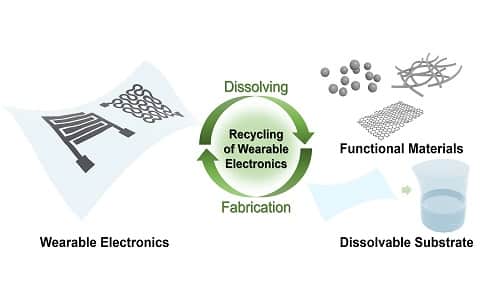The low-cost technique for retrieving nanowires from electronic devices makes use of low-surface tension solvent and ultrasound waves

In a step towards developing more sustainable electronics, researchers at the North Carolina State University have demonstrated a low-cost technique for retrieving nanowires from electronic devices that have reached the end of their utility and then use those nanowires in new devices.
“There is a lot of interest in recycling electronic materials because we want to both reduce electronic waste and maximise the use we get out of rare or costly materials,” says Yuxuan Liu, a PhD student at NC State. “We’ve demonstrated an approach that allows us to recycle nanowires, and that we think could be extended to other nanomaterials – including nanomaterials containing noble and rare-earth elements.”
In the novel recycling technique, the first step concerns designing devices using polymers that are soluble in solvents and will also not dissolve the nanowires. Once a device has been used, the polymer matrix containing the silver nanowires is dissolved, leaving behind the nanowire network. The network is then placed in a separate solvent and hit with ultrasound, which disperses the nanowires and separates them from the network.
“Our recycling technique differs from conventional recycling,” says Yong Zhu, Andrew A. Adams Distinguished Professor of Mechanical and Aerospace Engineering at NC State. “When you think about recycling a glass bottle, it is completely melted down before being used to create another glass object. In our approach, a silver nanowire network is separated from the rest of the materials in a device. That network is then disassembled into a collection of separate silver nanowires in solution. These nanowires can then be used to create a new network and incorporated into a new sensor or other devices.”
To demonstrate the procedure, the researchers created a wearable health sensor patch that tracked a patient’s temperature and hydration. The sensor consisted of silver nanowire networks embedded in a polymer material. A used sensor patch is normally discarded. Instead, the researchers dissolved the polymer in water, removed the nanowire network, broke it down into a collection of individual nanowires and then used those nanowires to create a brand-new wearable sensor. While a minor degradation in the properties of the nanowire network occurred after each “life cycle,” it was, however, found that the nanowires could be recycled four times without harming the sensor’s performance. After four life cycles, the performance of the nanowire network can be improved by introducing new silver nanowires into the mix.
“Using our approach, you get far more use from the nanowires,” Zhu says. “And even after the nanowires have broken down many times, to the point where they can’t be reused, we can still use them as feedstock for conventional recycling. It’s a tremendous reduction in waste.”
A critical requirement of the recycling process is to identify and obtain a solvent with a low surface tension with which the nanowire network can be disintegrated. “Low surface tension is important because it makes it easier for the solvent to diffuse into the narrow junctions between nanowires in the network, facilitating the disassembling of the network,” Liu says.
At the same time, an optimal balance needs to be maintained while subjecting the nanowire networks to ultrasound waves. If applied for too long, the nanowires can break. If not applied for long enough, then clumps of nanowires will be formed.
“The approach we’ve demonstrated here could be used to recycle other nanomaterials – such as nanoparticles, carbon nanotubes, other types of nanowires, and two-dimensional materials – as long as they are used in the form of a network,” Zhu says.
The work appears in the paper titled Recycling of Nanowire Percolation Network for Sustainable Soft Electronics and is published in the journal Advanced Electronic Materials.






